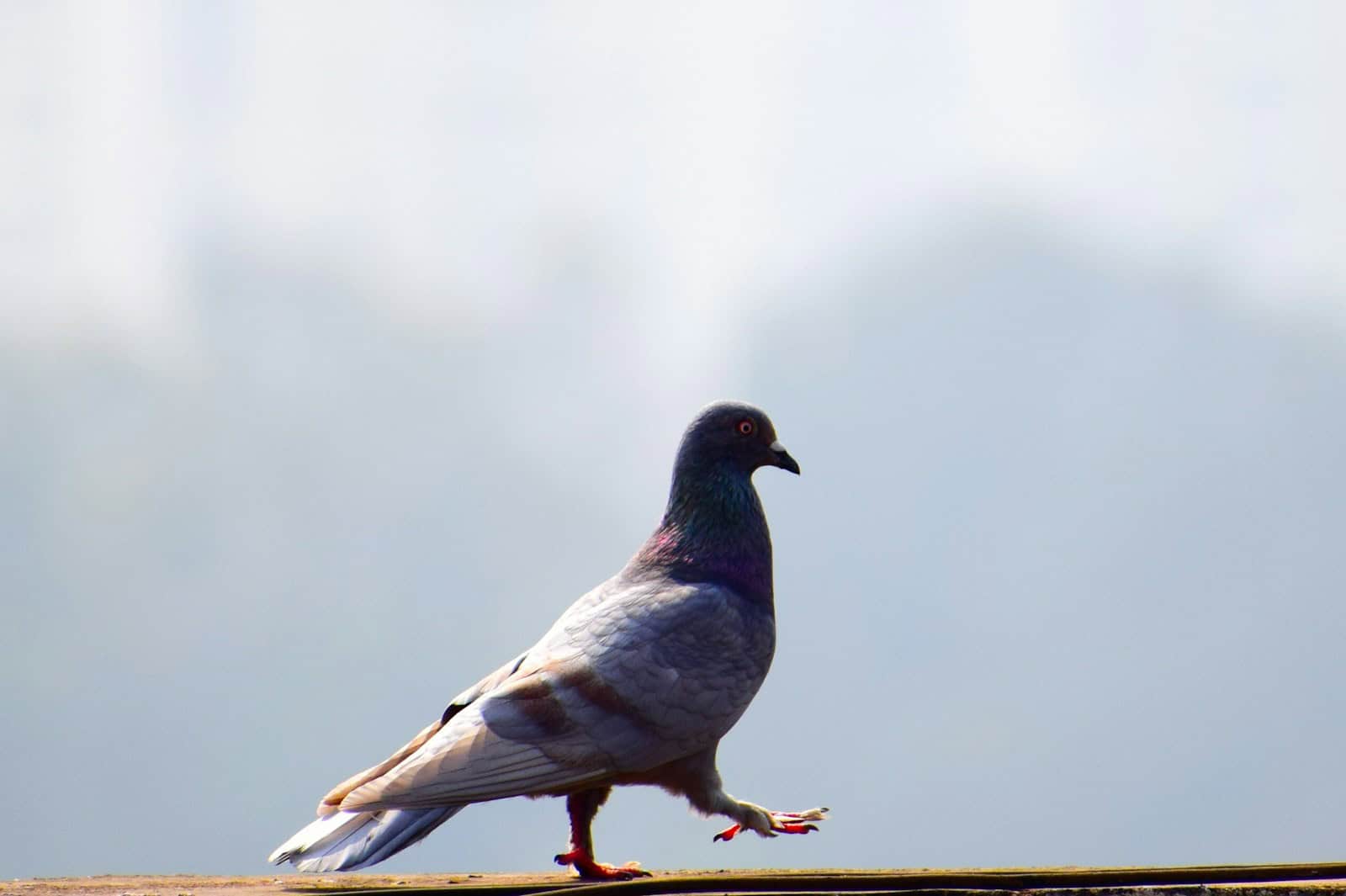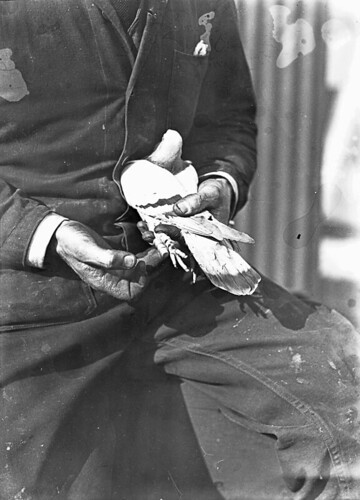In the show Game of Thrones and its prequel House of the Dragon, ravens are used to send messages between castles and cities in the Seven Kingdoms. This is a time where phones and electronic communication hasn’t been developed yet so ravens play a crucial role in long-distance communication. But while ravens are highly intelligent birds, they aren’t really all that useful (in real life) for that task. That distinction belongs to the carrier pigeon (also known as homing pigeons).
Carrier pigeons have been used throughout history for messaging due to their extraordinary ability to find their way home over long distances. The pigeons rely on their sense of direction, magnetic fields, smell, and hearing to navigate, and have been used in wars and diplomacy due to their reliability. They can “see” their way home using Earth’s magnetic fields and the sun for guidance, and also memorize landmarks with their sharp eyesight.
The way carrier pigeons work is that a group of pigeons living in one city, for example, San Diego, CA, are transported by humans to another city, such as Los Angeles, CA. Once released in Los Angeles, the pigeon would fly back to its home in San Diego. Obviously to make this useful you would attach some sort of message (think of a small slip of paper) to that bird and that message would travel between the two cities. Game of Thrones basically borrows this concept for the “send a raven” concept.
Ravens: The Westerosi Postal Service
Trained From Birth
Ravens in the world of Westeros and Essos are not ordinary birds. They are bred and trained from a young age by maesters. Maesters are the scholars, healers, and advisors of Westeros. They spend years teaching ravens to recognize specific locations and deliver messages to their intended destinations.
Castle-Specific Ravens
Each castle or stronghold has its own flock of ravens. These ravens are imprinted on their home location. They are trained to return to their home castle, no matter how far they fly. This is similar to how homing pigeons work in the real world.
Message Delivery
When a maester wants to send a message, they attach it to a raven’s leg. The raven is then released and flies instinctively towards the destination castle. Upon arrival, the recipient maester removes the message and sends a reply if needed.
Limitations of Raven Messaging
While ravens are a reliable way to communicate over long distances, there are some limitations.
- Speed: Ravens are not the fastest birds, so messages can take days or even weeks to reach their destination, depending on the distance.
- Vulnerability: Ravens can be attacked by predators or bad weather, which can lead to lost or delayed messages.
- Limited Information: Messages must be brief due to the limited space on the raven’s leg.
Alternative Communication Methods
In the world of Game of Thrones and House of the Dragon, there are alternative methods of communication, such as messengers on horseback or ships. However, these methods are slower and more dangerous than using ravens.

The Importance of Ravens
Despite their limitations, ravens are a vital part of communication in Westeros and Essos. They allow rulers to stay in touch with their vassals, armies to coordinate their movements, and families to communicate with each other.
The Mystery of Raven Intelligence
One of the most intriguing aspects of ravens in the Game of Thrones universe is their intelligence. They seem to possess a level of understanding beyond that of ordinary birds. This has led to speculation about whether they are simply well-trained or possess some kind of magical ability.
| Aspect | Details |
|---|---|
| Training | Trained from a young age by maesters to recognize specific locations. |
| Homing Ability | Imprinted on their home castle and return there instinctively. |
| Message Delivery | Messages are attached to their legs and carried to the destination castle. |
| Limitations | Can be slow, vulnerable to predators and weather, and limited information capacity. |
| Alternatives | Messengers on horseback or ships, but slower and riskier. |
| Importance | Vital for communication between rulers, armies, and families. |
| Mystery | Unusually intelligent, leading to speculation about their abilities. |
Carrier Pigeons: A Historical Reality
While ravens in the Game of Thrones universe are fictional, carrier pigeons are very real and have a long history of use for communication. They are domesticated pigeons specifically bred for their homing abilities, allowing them to return to their home loft from great distances.
How Carrier Pigeons Navigate
The exact mechanism by which carrier pigeons navigate is still not fully understood, but they are believed to use a combination of the following:
- Magnetoreception: The ability to sense the Earth’s magnetic field, which acts as a compass.
- Sun Compass: Using the position of the sun to orient themselves.
- Visual Landmarks: Recognizing familiar landscapes and landmarks.
- Olfactory Cues: Potentially using smell to navigate.
Historical Use of Carrier Pigeons
Carrier pigeons have been used for centuries to deliver messages, particularly in times of war and before the advent of modern communication technologies. Some notable examples include:
- Ancient Civilizations: Pigeons were used in ancient Greece, Rome, and Egypt to carry messages between cities and armies.
- World Wars: Both World War I and World War II saw extensive use of carrier pigeons for military communication, often with great success.
- Civilian Use: Pigeons were also used for civilian purposes, such as delivering news and stock prices.

Image Credit: https://www.flickr.com/photos/28853433@N02/46061403331
The Process of Using Carrier Pigeons
The process of using carrier pigeons for message delivery involved the following steps:
- Training: Pigeons were trained from a young age to return to their home loft. This involved gradually increasing the distance they were released from.
- Message Attachment: Messages were written on lightweight paper and attached to the pigeon’s leg with a small band.
- Release: The pigeon was released and would instinctively fly back to its home loft.
- Message Retrieval: Upon arrival, the message would be removed and delivered to the recipient.
Modern Applications of Carrier Pigeons
While carrier pigeons are no longer used for widespread communication, they still have niche applications. For example, they are sometimes used in remote areas where other forms of communication are unreliable. They have also been used in disaster response situations to carry messages from areas without power or cell phone coverage.
Key Takeaways
- Carrier pigeons navigate using magnetism, smell, and landmarks.
- They played important roles in wars and ancient communication.
- Pigeons’ brains help them process Earth’s magnetic fields for navigation.
History and Role of Carrier Pigeons
Carrier pigeons have served as vital messengers throughout history. Their use spans from ancient Greece and Rome to critical roles in World War I and World War II.
Ancient Use and War Contributions
Carrier pigeons were first used in ancient Greece and Rome. They sent messages across cities quickly. The Greeks used them to announce winners of athletic games. The Romans relayed critical information about battles.
In World War I, pigeons were crucial. Soldiers used them to send messages from the front lines when radio communication didn’t work. One famous pigeon, Cher Ami, delivered a vital message that saved nearly 200 soldiers of the “Lost Battalion”. Pigeons were also used in World War II, continuing their important role in military communication. They were noted for their speed and ability to return home even from distant and unfamiliar locations.
Decline and Legacy
Eventually, the use of carrier pigeons declined. Modern communication methods like radio and internet replaced them. Despite this, their legacy remains. They are remembered for their role in history, especially in wars.
Today, carrier pigeons are rarely used for message delivery. Instead, they are often bred for racing or as pets. They continue to be a symbol of communication and bravery. Memorials and museums have preserved their stories, honoring their contributions to human endeavors.
Biology and Behavior
Carrier pigeons are known for their remarkable ability to find their way home over long distances. These birds possess unique sensory capabilities and undergo training to develop their homing skills.
Sensory Capabilities and Homing Instinct
Carrier pigeons have an innate sense of direction. This helps them navigate back to their home. They use the Earth’s magnetic fields through magnetoreception, acting as an internal compass. Their keen eyesight allows them to spot landmarks and navigate effectively.
These pigeons also use the position of the sun and stars for navigation. Their sense of smell is another tool they use. By detecting familiar scents, they confirm their location and direction. This combination of senses makes them exceptional navigators.
Training and Bonding Processes
Training pigeons to carry messages involves starting from a young age. Pigeons are taken to short distances and released to allow them to fly back home. Over time, the distance is increased. This repeated practice strengthens their homing abilities.
The birds bond with their home loft, more than with the person training them. This bond is crucial. It ensures they always return to the same location. The process of gradually increasing the release distance helps in building their endurance and navigation skills.







